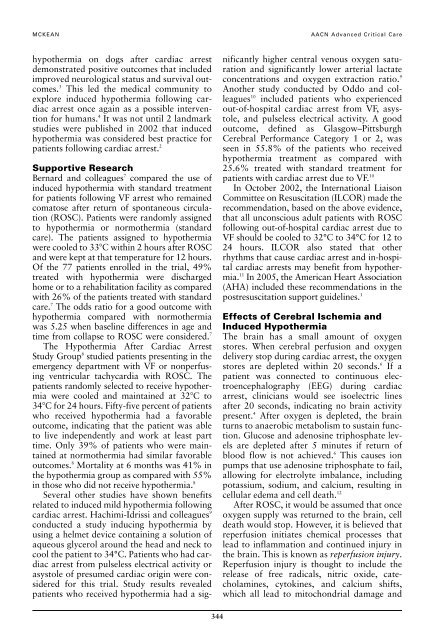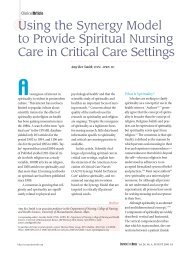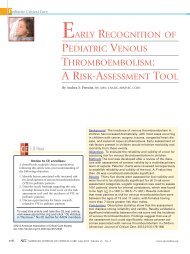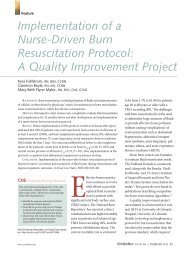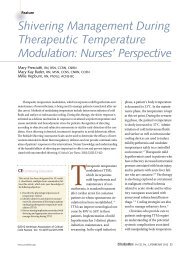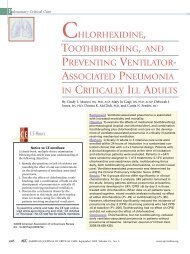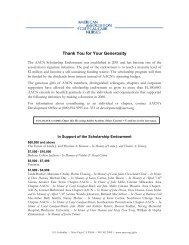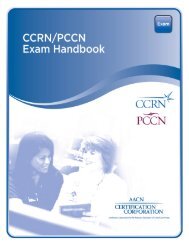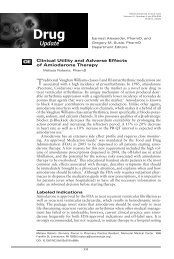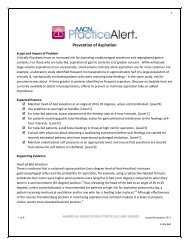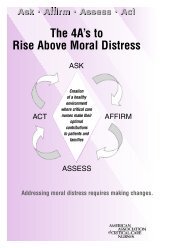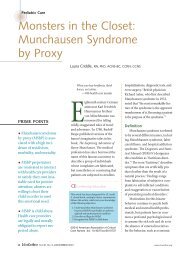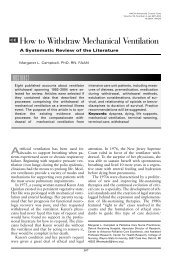Induced Moderate Hypothermia After Cardiac Arrest - American ...
Induced Moderate Hypothermia After Cardiac Arrest - American ...
Induced Moderate Hypothermia After Cardiac Arrest - American ...
Create successful ePaper yourself
Turn your PDF publications into a flip-book with our unique Google optimized e-Paper software.
MCKEAN<br />
AACN Advanced Critical Care<br />
hypothermia on dogs after cardiac arrest<br />
demonstrated positive outcomes that included<br />
improved neurological status and survival outcomes.<br />
3 This led the medical community to<br />
explore induced hypothermia following cardiac<br />
arrest once again as a possible intervention<br />
for humans. 4 It was not until 2 landmark<br />
studies were published in 2002 that induced<br />
hypothermia was considered best practice for<br />
patients following cardiac arrest. 2<br />
Supportive Research<br />
Bernard and colleagues 7 compared the use of<br />
induced hypothermia with standard treatment<br />
for patients following VF arrest who remained<br />
comatose after return of spontaneous circulation<br />
(ROSC). Patients were randomly assigned<br />
to hypothermia or normothermia (standard<br />
care). The patients assigned to hypothermia<br />
were cooled to 33C within 2 hours after ROSC<br />
and were kept at that temperature for 12 hours.<br />
Of the 77 patients enrolled in the trial, 49%<br />
treated with hypothermia were discharged<br />
home or to a rehabilitation facility as compared<br />
with 26% of the patients treated with standard<br />
care. 7 The odds ratio for a good outcome with<br />
hypothermia compared with normothermia<br />
was 5.25 when baseline differences in age and<br />
time from collapse to ROSC were considered. 7<br />
The <strong>Hypothermia</strong> <strong>After</strong> <strong>Cardiac</strong> <strong>Arrest</strong><br />
Study Group 8 studied patients presenting in the<br />
emergency department with VF or nonperfusing<br />
ventricular tachycardia with ROSC. The<br />
patients randomly selected to receive hypothermia<br />
were cooled and maintained at 32C to<br />
34C for 24 hours. Fifty-five percent of patients<br />
who received hypothermia had a favorable<br />
outcome, indicating that the patient was able<br />
to live independently and work at least part<br />
time. Only 39% of patients who were maintained<br />
at normothermia had similar favorable<br />
outcomes. 8 Mortality at 6 months was 41% in<br />
the hypothermia group as compared with 55%<br />
in those who did not receive hypothermia. 8<br />
Several other studies have shown benefits<br />
related to induced mild hypothermia following<br />
cardiac arrest. Hachimi-Idrissi and colleagues 9<br />
conducted a study inducing hypothermia by<br />
using a helmet device containing a solution of<br />
aqueous glycerol around the head and neck to<br />
cool the patient to 34°C. Patients who had cardiac<br />
arrest from pulseless electrical activity or<br />
asystole of presumed cardiac origin were considered<br />
for this trial. Study results revealed<br />
patients who received hypothermia had a significantly<br />
higher central venous oxygen saturation<br />
and significantly lower arterial lactate<br />
concentrations and oxygen extraction ratio. 9<br />
Another study conducted by Oddo and colleagues<br />
10 included patients who experienced<br />
out-of-hospital cardiac arrest from VF, asystole,<br />
and pulseless electrical activity. A good<br />
outcome, defined as Glasgow–Pittsburgh<br />
Cerebral Performance Category 1 or 2, was<br />
seen in 55.8% of the patients who received<br />
hypothermia treatment as compared with<br />
25.6% treated with standard treatment for<br />
patients with cardiac arrest due to VF. 10<br />
In October 2002, the International Liaison<br />
Committee on Resuscitation (ILCOR) made the<br />
recommendation, based on the above evidence,<br />
that all unconscious adult patients with ROSC<br />
following out-of-hospital cardiac arrest due to<br />
VF should be cooled to 32°C to 34°C for 12 to<br />
24 hours. ILCOR also stated that other<br />
rhythms that cause cardiac arrest and in-hospital<br />
cardiac arrests may benefit from hypothermia.<br />
11 In 2005, the <strong>American</strong> Heart Association<br />
(AHA) included these recommendations in the<br />
postresuscitation support guidelines. 1<br />
Effects of Cerebral Ischemia and<br />
<strong>Induced</strong> <strong>Hypothermia</strong><br />
The brain has a small amount of oxygen<br />
stores. When cerebral perfusion and oxygen<br />
delivery stop during cardiac arrest, the oxygen<br />
stores are depleted within 20 seconds. 6 If a<br />
patient was connected to continuous electroencephalography<br />
(EEG) during cardiac<br />
arrest, clinicians would see isoelectric lines<br />
after 20 seconds, indicating no brain activity<br />
present. 4 <strong>After</strong> oxygen is depleted, the brain<br />
turns to anaerobic metabolism to sustain function.<br />
Glucose and adenosine triphosphate levels<br />
are depleted after 5 minutes if return of<br />
blood flow is not achieved. 6 This causes ion<br />
pumps that use adenosine triphosphate to fail,<br />
allowing for electrolyte imbalance, including<br />
potassium, sodium, and calcium, resulting in<br />
cellular edema and cell death. 12<br />
<strong>After</strong> ROSC, it would be assumed that once<br />
oxygen supply was returned to the brain, cell<br />
death would stop. However, it is believed that<br />
reperfusion initiates chemical processes that<br />
lead to inflammation and continued injury in<br />
the brain. This is known as reperfusion injury.<br />
Reperfusion injury is thought to include the<br />
release of free radicals, nitric oxide, catecholamines,<br />
cytokines, and calcium shifts,<br />
which all lead to mitochondrial damage and<br />
344


